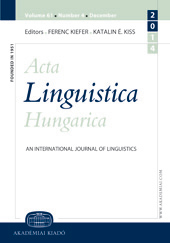Demonstrative pronouns in spatial deixis, discourse deixis, and anaphora
Demonstrative pronouns in spatial deixis, discourse deixis, and anaphora
Author(s): Krisztina LaczkóSubject(s): Pragmatics, Finno-Ugrian studies
Published by: Akadémiai Kiadó
Keywords: spatial deixis; event deixis; discourse deixis; anaphora; perspective;
Summary/Abstract: This paper explores the relationship between the use of demonstrative pronouns in deixis and anaphora in the framework of the functional-cognitive theory of language. Part of the international literature suggests that deixis and anaphora cannot be separated from one another (see, in a formal pragmatic framework, Lyons 1977/1989; Levinson 1994), whereas other authors think that those two pragmatic/text linguistic processes are not connected in this manner (see, e.g., the cognitive-functional approach of Marmaridou 2000). The way Hungarian demonstratives work does not support the latter claim. Along with universal characteristics, it can be observed in Hungarian that, in the non-attributive (independent) use of these pronouns, event deixis (a subtype of spatial deixis) exhibits properties that it shares with discourse deixis, whereas discourse deixis leads on to the anaphoric use of demonstratives. In Hungarian, the switchover between the two types of use is clearly associated with perspective; in particular, with the shift from the referential centre to a neutral vantage point.
Journal: Acta Linguistica Hungarica (Since 2017 Acta Linguistica Academica)
- Issue Year: 57/2010
- Issue No: 1
- Page Range: 99-118
- Page Count: 20
- Language: English

